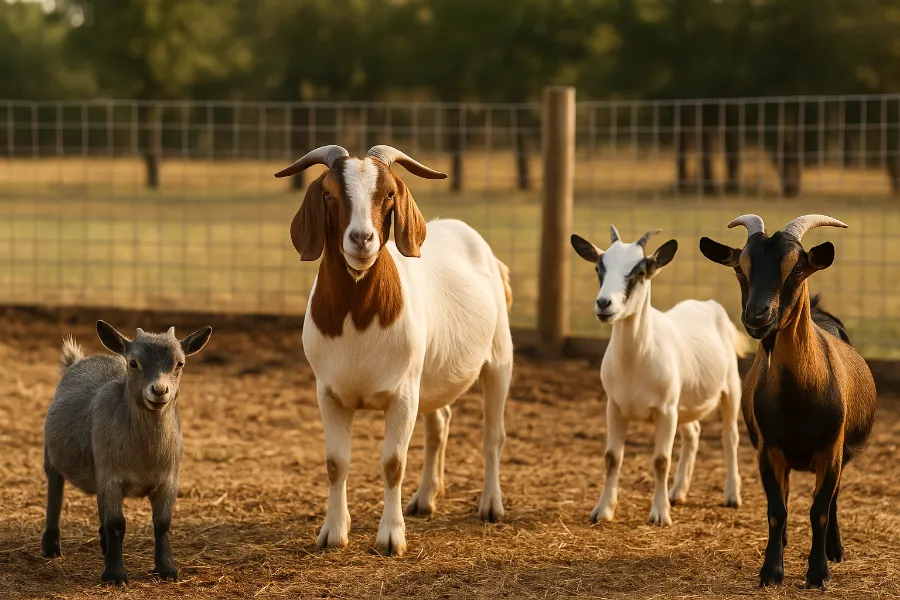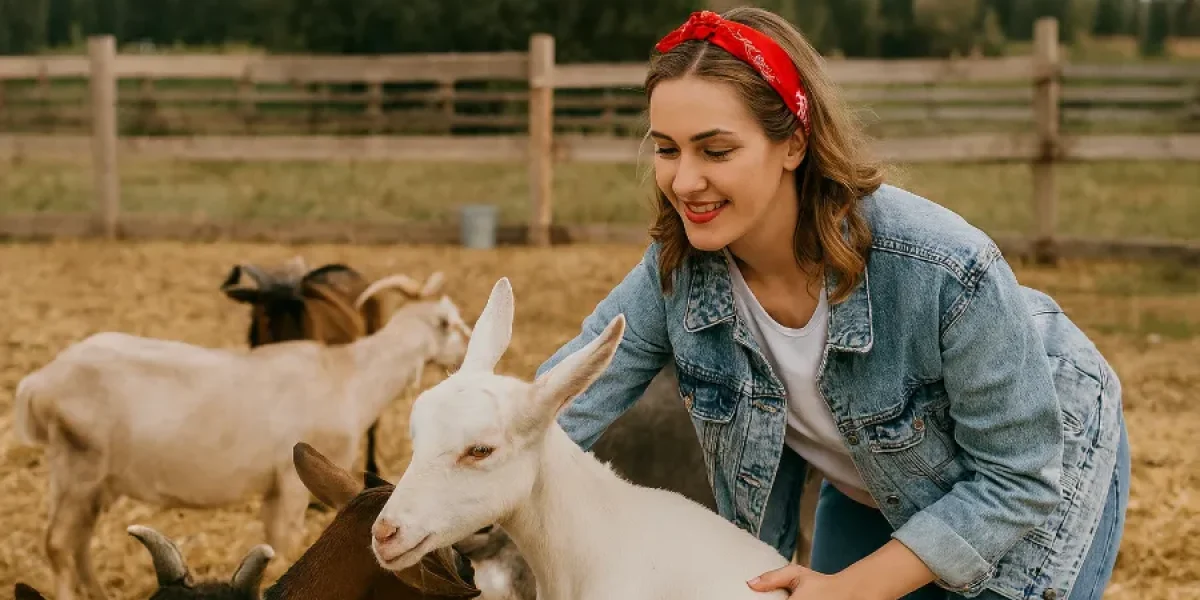When I first started raising goats, I was both excited and overwhelmed. Everyone seemed to have advice: some said goats would eat everything in sight, others swore they were the easiest livestock you could own. The truth? It’s somewhere in the middle. Goats are quirky, loveable, and surprisingly smart—but they also require real care and commitment. In this post, I’m going to walk you through what I’ve learned, using the most common questions people have and tackling everything from breeds to health to fencing.

Pygmy Goats
If you’ve ever seen a picture of a chubby little goat bouncing around, chances are it was a pygmy goat. They’re often the first breed new owners consider because of their small size and playful nature.
I’ve had a few raising pygmy goats as pets, and they were absolutely delightful. They don’t take up as much space as larger breeds, and their personalities are charming. But don’t let their cuteness fool you—they still need strong fencing, regular hoof care, and companionship. Pygmies make great family goats, especially if your main goal is fun rather than milk or meat.
Nubian Goats
Next on the list are Nubian goats, famous for those floppy ears and loud voices. My first dairy goat was a Nubian, and let me tell you—they will tell you when they want something. But their milk? Worth every bit of effort.
Nubian goats for milk production are known for their rich, high-butterfat milk, which is amazing if you want to make cheese or yogurt. They’re also social and affectionate, but you’ll need to be ready for their volume. If your neighbors aren’t goat people, they may not love the constant bleating. Still, if you want a goat that gives you dairy and plenty of personality, Nubians are hard to beat.
Boer Goats
When people ask me about raising goats for meat, I almost always bring up Boer goats. Originally from South Africa, they’re stocky, muscular, and bred to grow quickly.
I don’t raise Boers for meat myself, but I’ve had friends who do, and they swear by the breed. Boer goats for meat farming are hardy, adapt well to different climates, and produce a lot of meat compared to other breeds. Just keep in mind—they eat a lot more than smaller goats, so your feed bill will reflect that.
Alpine Goats
Alpine goats have my heart when it comes to consistent milk production. Unlike Nubians, their milk isn’t as high in butterfat, but they make up for it in quantity. If you want gallons of milk every week, Alpines are your best friend.
What I love most about Alpines is how hardy they are. They can handle hot summers and cold winters better than many breeds, which makes them a reliable choice for Alpine goats for homesteading. They’re also friendly and social, which makes them easy to work with.
Goats for Pets
A lot of people ask me: “Can goats really be pets?” The answer is yes—goats for pets are becoming more popular. I’ve had goats that were every bit as affectionate as dogs. They’ll follow you around, play with toys, and even climb into your lap if you let them.
But here’s the catch: goats are herd animals. They can’t live alone. If you want a pet goat, you need at least two. They also need outdoor space, secure fencing, and regular care. They’re not low-maintenance backyard ornaments—they’re living, breathing animals with real needs.

Goat Hoof Trimming
If there’s one chore every goat owner needs to get comfortable with, it’s how often to trim goat hooves. Overgrown hooves can cause infections, pain, and difficulty walking.
The first time I trimmed hooves, I was nervous. But with practice, it became just another routine task. Most goats need their hooves trimmed every 4–6 weeks. I use a sharp pair of hoof trimmers (not garden shears or scissors), and I always keep some antiseptic nearby in case of nicks.
Trimming hooves is also a good chance to check for signs of illness or parasites. It may not be glamorous, but it’s one of the most important parts of goat care.
Goat Deworming
Parasites are one of the biggest health challenges when raising goats. That’s where goat deworming and parasite control comes in.
In the early days, people used to give goats dewormers on a regular schedule. But now, many vets recommend doing fecal tests first to see if your goats actually need treatment. This helps prevent dewormer resistance, which is becoming a real issue.
I’ve learned to watch for warning signs like weight loss, rough coats, or pale eyelids. Rotating pastures and keeping pens clean also makes a huge difference. When deworming is necessary, I always consult my vet for the right product and dosage.
Goat Vaccinations
If you’re new to goats, you might not realize just how important CDT vaccinations for goats explained are. The big one is CDT, which protects against two types of enterotoxemia and tetanus.
I vaccinate my goats every year, and pregnant does get an extra shot before kidding so their kids are protected early on. Depending on where you live, your vet may recommend additional vaccines. A few minutes with a needle can prevent heartbreak later—it’s one of those things you should never skip.
Sweet Feed for Goats
I get asked all the time about sweet feed for goats. Should you feed it? The answer: occasionally, and with caution.
Is sweet feed safe for goats? Yes, but only as a treat. Sweet feed is grain coated in molasses. Goats love it, but it’s more of a treat than a staple. I use it sparingly, usually when I need to train or bribe a goat. Too much sweet feed can cause obesity or digestive issues. The foundation of a goat’s diet should always be good hay, pasture, and minerals. Think of sweet feed like candy—it’s fun once in a while, but not every day.
Goat Fencing

If you’ve heard that goats are escape artists, believe it. Best fencing for goats to prevent escapes is one of the most important investments you’ll make.
I’ve chased goats through fields, across roads, and once even onto my neighbor’s porch. Lesson learned: goats will test your fence. Woven wire at least four feet high works best. I also run a strand of electric wire along the top just to discourage climbing.
Good fencing doesn’t just keep your goats in—it keeps predators out. Whether it’s coyotes, stray dogs, or raccoons, your goats need protection. Trust me, skimping on fencing will cost you more in the long run.
Myths About Raising Goats
Over the years, I’ve heard plenty of myths about raising goats. Here are a few I can bust for you right now:
- Myth: Goats eat tin cans.
Truth: They’ll chew the paper label but not the metal. - Myth: Goats can live alone.
Truth: They’re herd animals and get depressed without companions. - Myth: Goats eat everything.
Truth: They’re actually picky. Some plants (like azaleas or oleander) are toxic to them.
This section is especially important for myths about raising goats debunked, because understanding these misconceptions early on can save you frustration—and maybe even a goat’s life.
Final Thoughts on Raising Goats
Raising goats has been one of the most rewarding adventures of my homesteading journey. Whether you’re drawn to pygmy goats for fun, Nubian goats for milk, Boer goats for meat, or Alpine goats for reliability, there’s a breed that fits your lifestyle.
But goats aren’t just “easy backyard animals.” They need secure fencing, regular hoof trims, deworming, vaccinations, and a good diet. Treat them well, and they’ll reward you with companionship, productivity, and endless entertainment.
If you’re ready to take the leap, do your research, start small, and enjoy the ride. Raising goats isn’t just about farming—it’s about building a bond with some of the most mischievous, lovable animals you’ll ever meet.
FAQs
Pygmy, Nubian, Alpine, and Boer goats are great options depending on your goals. Pygmies are perfect as pets, Nubians and Alpines for milk, and Boers for meat.
No, goats don’t eat tin cans or random junk. They are browsers and prefer shrubs, weeds, and certain plants, but some plants can be toxic.
Most goats need hoof trims every 4–6 weeks. Regular trimming prevents lameness, infections, and other health problems.
Deworming should be done strategically, not on a strict schedule. Fecal tests and vet guidance help avoid drug resistance.
Yes, goats benefit from vaccines like CDT, which protect against tetanus and enterotoxemia. Annual boosters and regional vaccines may be recommended by vets.
Sweet feed is best as an occasional treat, not a daily staple. Too much can cause obesity and digestive issues, so hay and minerals should come first.
Sturdy woven wire fencing at least four feet tall is the most reliable. Adding an electric strand helps keep goats in and predators out.













